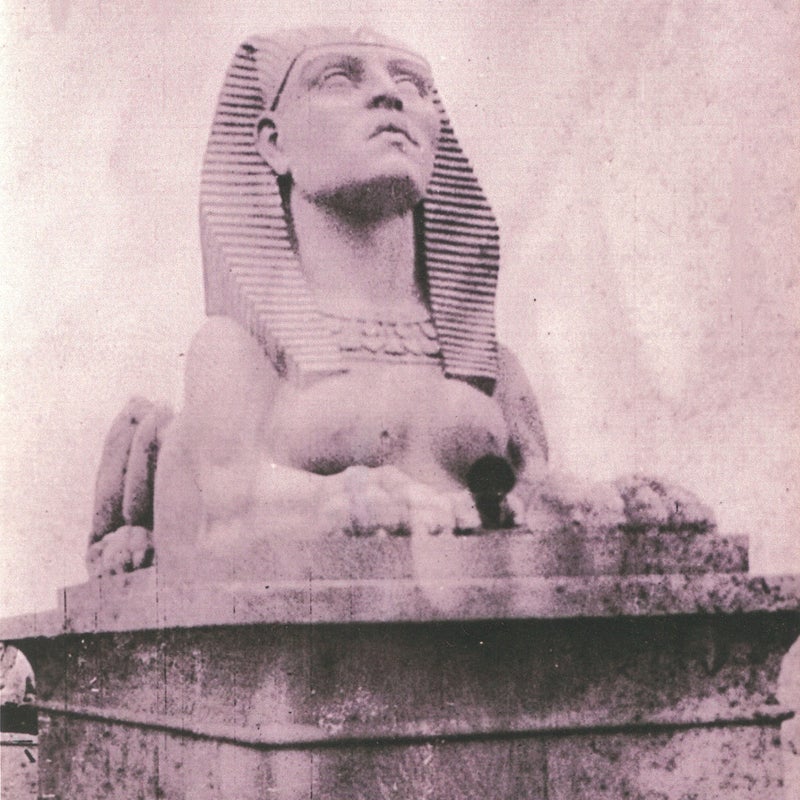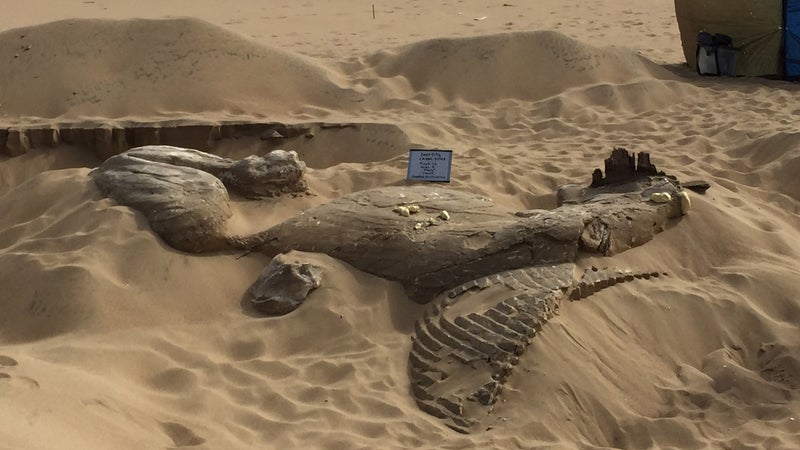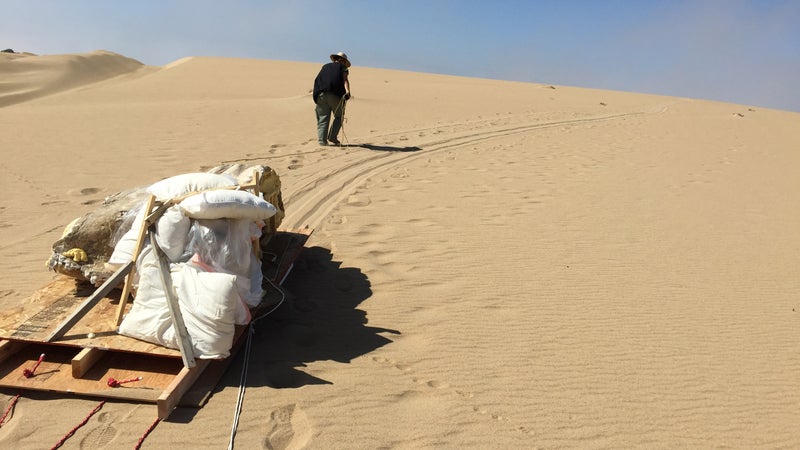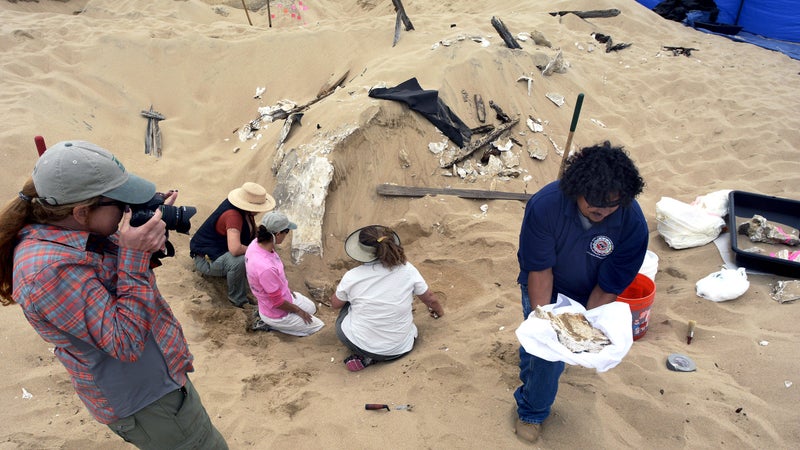The Cursed, Buried City That May Never See The Light of Day
It was the biggest set ever built for a Hollywood film in the 1920s, and then it was buried in the sands of the California Coast. The real story begins when a young filmmaker embarks on a decades-long attempt to excavate it.
New perk: Easily find new routes and hidden gems, upcoming running events, and more near you. Your weekly Local Running Newsletter has everything you need to lace up! .
Thirty-three years ago, Peter Brosnan heard a story that seemed too crazy to be true: buried somewhere along California’s rugged Central Coast, beneath acres of sand dunes, lay the remains of a lost city. According to his friend at New York University’s film school, the remains of a massive Egyptian temple, a dozen plaster sphinxes, eight mammoth lions, and four 40-ton statues of Ramses II were all supposedly entombed in the sands 150 some-odd miles north of Los Angeles.
“It was an absolutely cockamamie story,” Brosnan says. “I thought he was nuts.” The ruins weren’t authentic Egyptian ones, of course. They were the 60-year-old remains of a massive Hollywood set—the biggest, most expensive one ever built at the time. The faux Egyptian scenery had played the role of the City of the Pharaoh in one of Hollywood’s first true epics, Cecil B DeMille’s 1923 film The Ten Commandments. The set had required more than 1,500 carpenters to build and used over 25,000 pounds of nails. The production nearly ruined DeMille and his studio. When the shoot wrapped, the tempestuous director supposedly strapped dynamite to the structures and razed the whole set, burying it in the sands near Guadalupe, California, to ensure no rival director could benefit from his vision.
“If 1,000 years from now archaeologists happen to dig beneath the sands of Guadalupe,” the director teased, “I hope they will not rush into print with the amazing news that Egyptian civilization…extended all the way to the Pacific Coast.”
Bullshit, Brosnan thought. But then his buddy pointed him to a line in DeMille’s posthumously published autobiography. “If 1,000 years from now archaeologists happen to dig beneath the sands of Guadalupe,” the director teased, “I hope they will not rush into print with the amazing news that Egyptian civilization…extended all the way to the Pacific Coast.”
By 1982, Brosnan had graduated from film school and was earning a living as a freelance journalist, but he couldn't shake his friend's story. The film student in him was enchanted by the idea of uncovering and preserving a forgotten bit of Hollywood’s history. That summer, Brosnan and his friend drove across the country, from New York City to a stretch of coast near Santa Barbara, to see the ruins for themselves. The whole affair, he thought, would make for a hell of a documentary.
“We were young, wannabe filmmakers, and I thought this was golden,” Brosnan says today. “We’ll find some archeologists, we’ll find the set, we’ll dig it up. The story writes itself.”
The City of the Pharaoh was not so much a movie set as it was a monument to the man who built it. DeMille was already a towering star in the early days of Hollywood, but in 1922 he was recovering from a streak of critical flops. He had gained a reputation for his sense of spectacle in films like Joan the Woman and Male and Female, and The Ten Commandments was to be his comeback.
Delivering DeMille’s blockbuster meant deploying a barrage of special effects, at least by the standards of the day. In 1923, set design was the only way to visually transport viewers to the Sinai in the time of Moses. The “desert” DeMille chose for his Israelites to wander, while certainly more convenient than filming on location in Egypt, presented a logistical nightmare. There were no nearby cities, no paved roads, and no place for his cast of thousands to stay. The 22,000 acres of sand dunes that separated the small farming town of Guadalupe from the Pacific Ocean was harsh and desolate. The sharp-grained sand that gives the wind there its added sting is devoid of nutrients, and, combined with constant salt sprays from the sea, makes life a rarity in the dunes. For DeMille, it was perfect.

“Your skin will be cooked raw,” DeMille told his army of 3,500 actors and extras, according to a Los Angeles Times reporter on the scene. “You will miss the comforts of home. You will be asked to endure perhaps the most unpleasant location in cinema history. I expect of you your supreme efforts.”
The costs were mounting even before DeMille arrived in Guadalupe to begin shooting. Preproduction expenses were already approaching $700,000—an astronomical sum in the early days of Hollywood. More than a million pounds of statuary, concrete, and plaster were used to construct the 120-foot-tall, 800-foot-long temple and surrounding structures, and whole plaster sphinxes were sculpted and loaded onto trucks bound for the dunes. Every day on location meant feeding and housing the thousands of workers and animals. DeMille drove his construction team to work faster. Paramount Studios, the film’s backer, began sending DeMille increasingly desperate letters demanding that he cut costs. One receipt, for $3,000 spent on a “magnificent team of horses” for the pharaoh, pushed the studio over the edge, according to Sumiko Higashi, a professor emeritus at The College at Brockport, SUNY, and author of Cecil B. DeMille and American Culture: the Silent Era, a biography of DeMille.
“You have lost your mind,” telegraphed Adolph Zukor, founder of Paramount Pictures. “Stop filming and return to Los Angeles at once.” DeMille refused. He took out a personal loan and waived his guaranteed percentage of the movie’s gross to ensure the production continued. “I cannot and will not make pictures with a yardstick,” he wired back to the studio. “What do they want me to do?” he was rumored to have said, according to Higashi. “Stop now and release it as The Five Commandments?”
Despite the warnings, DeMille pushed on. Bugles sounded every morning to 4:30 a.m. to wake the 5,000 workers and actors that populated the 24-square-mile tent city he’d built in the dunes. (It earned the nickname the City of DeMille.) His workers raised the 109-foot-tall Great Gate—an archway covered in intricate busts of rearing stallions—and buttressed it with two 35-foot-tall clay-and-plaster statues of the Pharaoh. They erected a “city wall”—built 750 feet long because DeMille refused to work with painted backgrounds or limit his cinematic choices. Five mammoth sphinxes, weighing over five tons each, lined the entrance to the ersatz Egyptian city.
Filming was done at a madcap pace and condensed into a mere three weeks, according to Scott Eyman’s biography, Empire of Dreams: The Epic Life of Cecil B. DeMille. But even with the Exodus in the can, one more problem loomed. According to a prior agreement with the landowners, DeMille’s monumental set had to be dismantled before he left. Production costs had already ballooned to over $1.4 million, more than any other film previously made. DeMille considered reneging on the deal, Brosnan says, but likely worried about another issue: If he left is city standing, rival directors from other studios could easily swoop into Guadalupe and produce an epic on the cheap. DeMille would not have that. Rather than pay workers to take the set down, he settled on a faster method. Dynamite was supposedly strapped to the great temple he had built, and the City of the Pharaoh was brought down. According to legend, he ordered bulldozers to mound sand over the scattered remains and quickly left town.
Sixty years later, in 1983, Brosnan arrived at the dunes like the Children of Israel before him—completely lost. He knew the set was buried somewhere, but the dunes stretched nearly 30 miles, across two counties. Looking for clues, he called the Air Force base that occupied much of the coastline. (“Sir,” he says the sergeant on the other end of the line told him, “There is no Egyptian city buried at Vandenberg Air Force Base.”) He haunted local libraries. He hounded municipal politicians. No one could provide hints about the set’s exact location.
Then he stumbled upon an old ranch hand at a local tavern who had run cattle through the dunes for decades. On a cold and dark morning, after a savage storm had rearranged the topography of the dunes, Brosnan and the rancher hiked the sea of hundred-foot-high peaks, making their way a mile toward the pounding surf of the Pacific. Eventually they spied what locals called “the dune that never moves”—the sandy tomb that covered DeMille’s set—and saw a chunk of Plaster of Paris statuary poking through.

The discovery made headlines around the world and Brosnan fielded calls from The New York Times, NBC Nightly News, and People magazine. His documentary idea, which had seemed pie-in-the-sky a few months earlier, looked promising. And his pitch—that the lost city is the oldest existing Hollywood set left; that props from more modern shoots have already been preserved for posterity; that early set design was, in a sense, an American art form—struck a chord in the industry. Brosnan tentatively called his documentary project The Lost City.
Charlton Heston, star of DeMille’s 1956 remake of the film, publicly wished the project well, and local archaeologists volunteered their time to help in the excavation. A curator at the Smithsonian expressed interest in acquiring some pieces, once the dig wrapped. Promises for funding came in from Paramount Pictures and Bank of America. Brosnan moved to Hollywood with the intention of pursuing a career in the ‘biz. But first, he had to start digging.
“This will be a scientific exploration by highly trained personnel,” said a Cambridge-educated archaeologist who signed on in 1983. “Not a case of simply digging up stuff like potatoes. And if we're serious about documenting movie history, then let's do it properly.”

The excavation and documentary progressed, but Brosnan constantly faced two problems: funding and permitting. When he had the money, the county wouldn’t let him touch the environmentally sensitive area. (The western snowy plover, a federally protected species that nests along california’s coast, keeps the dunes off limits to people for half the year during breeding season.) By the time he got permission to dig, seven years later, funding had dried up. In 1990, several organizations, including the Smithsonian and the DeMille Family Trust, agreed to partially fund the project, and Brosnan and an archeologist used ground-penetrating radar to show that much of the set remained intact. But he couldn’t raise enough money to excavate the actual ruins. He needed $175,000 for an archeological dig to recover 60-year-old fake relics. “We don't see this as a fake Egypt,” Brosnan told a reporter at the time. “We see this as real cinema history.”
But by the mid-1990s, Brosnan had been scraping by in the movie business for a decade, writing scripts and directing small projects. Lacking the money, he gave up the dig.
That DeMille’s ruins have survived intact to this day, albeit buried in the sands, is a quirk of geography. The dunes, which cover some 35 square miles of the coast here, formed about 15,000 years ago, according to Doug Jenzen, executive director of the non-profit Dunes Center in Guadalupe. Jenzen and his team run a small museum out of a craftsman on the town’s main (and only) drag and head up conservation efforts for the Dunes preserve. It’s a charming little museum that seems out of place among the shuttered movie theater and boarded up buildings of Guadalupe, but the Dunes and DeMille are the only source of tourism dollars in this largely agricultural area, Jenzen says.
Thousands of years ago, rivers swept mineral-dense rocks and boulders from the nearby coastal range down to the sea, eventually pummeling the earth into fine grain sand. “One of the reasons the movie set is preserved so well is because of the minerals in the sand,” Jenzen says. “You know how when you order something mail order and it comes with the silica packets? The sand actually acted as a natural desiccant that preserved the plaster for the statues.”
For 15 years, the ruins were left undisturbed. Every few years a reporter or a researcher would call and Brosnan would humor him or her with details of his odyssey in the dunes. Each time, he hoped the new round of publicity would inject dollars into the effort, but nothing ever came through.

In 2010, though, after the Los Angeles Times ran yet another piece on his unfinished dig, a woman—who wishes to remain anonymous—contacted Brosnan and offered to put up the money needed to finish the film. But by then he was married with children and had been away from the project for two decades. “My first response was a moment of panic,” Brosnan says. “There’s no way I could do this.”
But Brosnan hired a producer and an editor, and last fall, with the help of a Santa Barbara County grant, a team of archeologists excavated most of a sphinx. Brosnan was on hand to film it. “We had always wanted to end with a shot of the sphinx being found. And we got it,” he says. Using his early footage shot in the 1980s, Brosnan has pulled together a rough cut and has an editor working on a final draft. He says he’s looking for distributors and considering the film festival circuit soon.
In the Dune Center, Jenzen and his team display parts of one of the large plaster sphinxes and smaller relics that have been successfully pulled from the sand. “All of the statues were made of plaster,” he says. “They were built to last two months—92 years ago. I don’t think this could have happened anywhere else on earth.”
However, Jenzen says the ruins may not survive another 92 years. Powerful storms in the last few years have shifted the sands of the dunes dramatically—more of the set is now exposed to the elements than ever before. The Dunes Center needs $100,000 to unearth another sphinx to add it to the display, Jenzen says, before it’s too late. “It’s disappearing so fast,” he says, “Archeologists originally thought it’d last until 2090—but every time we go out, more is gone.”


